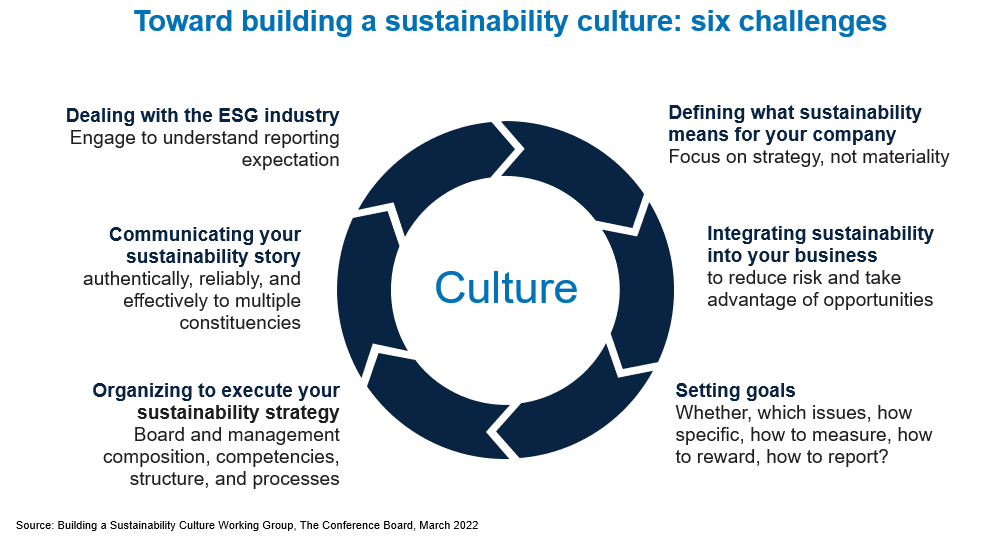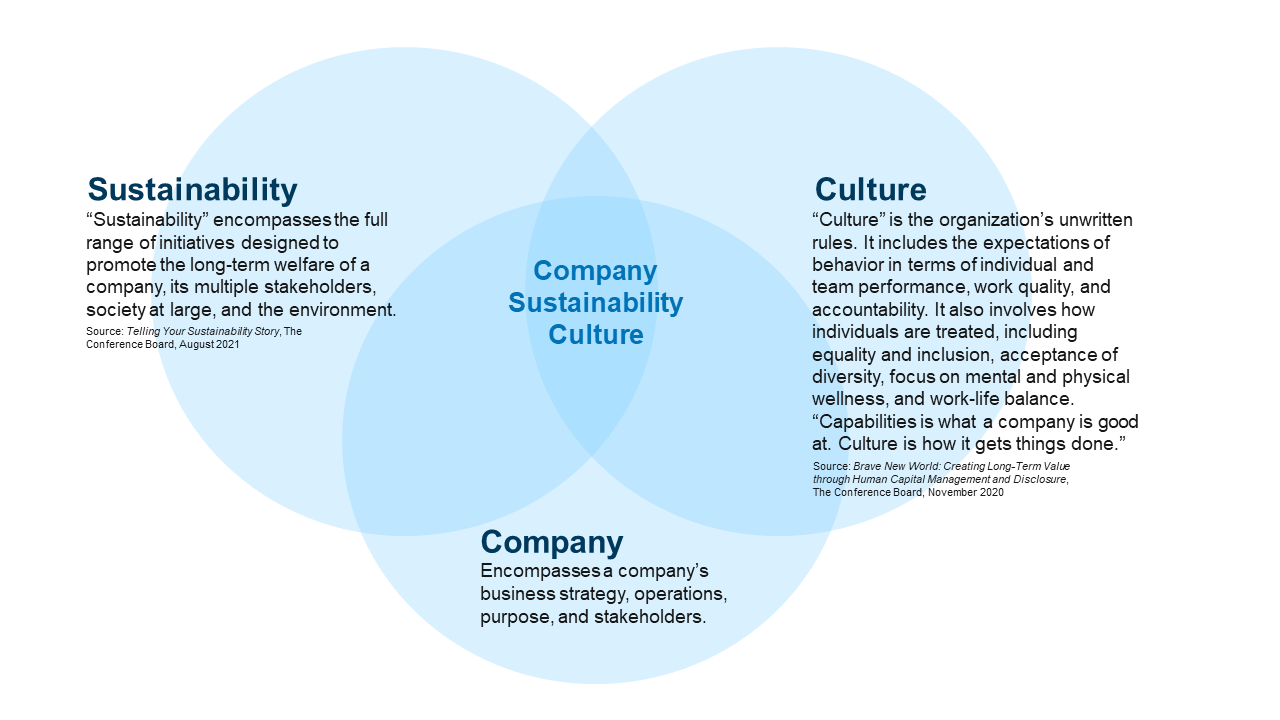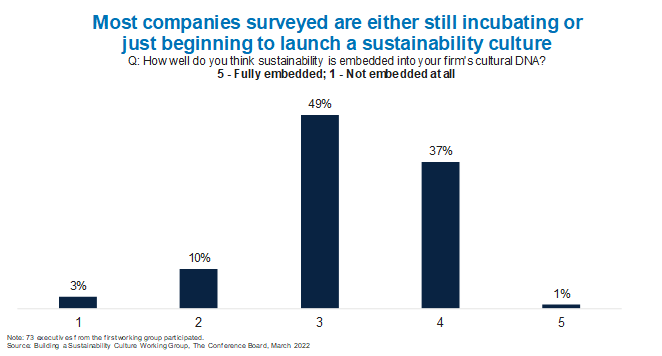These ongoing challenges evolve as both stakeholder expectations and the company’s business change, and sustainability programs mature as the company inevitably learns from successes and failures along the way.
At the heart of addressing the six key challenges is creating a “sustainability culture” in which those at the organization—from the top of the house through frontline workers—think and act with sustainability in mind. That is the core element that assures a company’s sustainability efforts endure through changes in corporate leadership and government administrations.

| |
This brief addresses what a sustainability culture is, provides the scope of the challenge for companies seeking to build such a culture, and offers a set of principles to help guide the effort. It is the first of four thought leadership briefs on the subject, based on a series of Chatham House Rule working group1 convenings held by The Conference Board ESG, Human Capital, and Marketing & Communications Centers and sponsored by Baker Tilly. The insights, guidance, and best practices from the working group sessions will help inform the subsequent briefs and a full report at the end of 2023.
|
|
Insights for What’s Ahead
In our first working group session on Building a Sustainability Culture with executives from more than 100 Member companies of The Conference Board, it became clear that embedding sustainability into business strategy and day-to-day operations is the biggest of the six key challenges facing companies. Firms are moving beyond simply complying with laws and regulations governing ESG topics. They’re grappling with how to meet investor and customer expectations, how to mitigate risk, and how to seize opportunities. They recognize that if sustainability is built into their culture, they’ll be able to make their company an innovation engine in sustainability.
There’s no such thing as a generic sustainability culture; it’s highly company specific. As shown in the diagram, it’s not enough for a firm to take the notions of sustainability and corporate culture, combine them, and voilà!—you have the company’s sustainability culture.

Instead, you need to consider the company’s business, its existing culture and sustainability efforts, its mission and purpose, and its aspirations. Among other things, you also need to consider how far a company needs or wants to go in this effort: Is sustainability an enhancement to a current culture? Is it a more profound shift that involves embracing and integrating a new sense of purpose throughout the organization? Or is it part of an existential transformation necessary for the success or even survival of the company?
Perhaps somewhat counterintuitively, the more fundamental the business transition, the easier it may be to build sustainability into the culture. If your firm is undergoing a fundamental business shift, you have an opportunity to connect your sustainability efforts to that change. For example, one company undergoing a digital transformation mapped out cultural traits required for transformation, including ingenuity, connectivity, discipline, focus, empowerment, openness, transparency, and collaboration. The company translated those qualities and soft skills to leadership profiles, built training programs around them, and incorporated them in the onboarding process for new employees.
Building a sustainability culture is hard work that begins with adopting a common language and understanding of sustainability goals. One of the challenges with building a sustainability culture is establishing a common terminology and having a shared sense of what sustainability is. Our research shows that most companies don’t have internal clarity on the meaning of sustainability. In a 2021 poll, we found that only a third (32 percent) of companies have a strong agreed-upon definition of sustainability across the business2 and there’s no universally accepted definition of sustainability.3 This lack of a common language makes it harder to build a sustainability culture, which by its very nature needs to be company specific.
You can think of a sustainability culture as building an awareness of your company’s impact in a few key areas and goals for the long-term welfare of the company’s stakeholders, society at large, and the natural environment, so that your board, your C-suite, and your workforce think and act with those common objectives in mind. Changing cultures is hard because it requires changing norms and values, often ones that are deeply held. Companies on a sustainability journey need to be sensitive to the culture that already exists and intentional about engaging people in implementing change. At one firm, for example, internal sustainability ambassadors run culture workshops where they discuss how sustainability objectives are integrated with the business and what behaviors are associated with achieving them, and videos of those workshops are shared on an internal website.
A culture shift is about far more than setting the tone at the top. It needs to take hold in the middle where the business units make decisions, run day-to-day operations, lead innovations, develop products, and manage risks. Companies we surveyed said they’re at the early to middle stages of building a sustainability culture. As shown in the chart, which captures the results of a poll of the 73 executives who participated in our first session of the working group, most companies are still at a relatively early stage.

Ideally, a company should build a sustainability culture not just at corporate headquarters but also—to the extent possible—throughout its value chain. A code of conduct alone cannot build this culture; it involves working with suppliers and other business partners to set common goals and plans—for example, a program to protect human rights in the supply chain. One-on-one dialogue with your business partners is necessary to set mutual expectations and agree on key sustainability issues and the ways to address them. How far up and down the value chain a firm can reach will vary, depending greatly on its scale, role in the marketplace, and relationships built over time.
Guiding Principles
To help companies overcome the six challenges, the working group identified five principles to building a sustainability culture.
- Focus on one to three sustainability priorities you want to build into your culture. When you’re trying to change the culture of an organization, adding just one element can be hard enough. Set a few key goals and educate the organization—everyone from the frontline workers to the board—about their role in achieving those goals. It’s OK to make incremental progress as long as you’re achieving concrete results.
- Ensure that your company’s mission, purpose, and values are not only clearly articulated, but also well understood and embraced. A company's mission is what it does (and for whom); its purpose is why it exists; and its values are core pillars of how it behaves—that is, its culture.4 These are interrelated and interdependent concepts: a company’s purpose (why it exists) doesn’t mean much without understanding its mission (what it does). In shifting a company’s culture, it’s important to have a consensus on all of these topics, as well as a shared sense of urgency.
- Create a sense of ownership. A sustainability culture requires a sense of ownership so that everyone feels invested in it. Ownership is a powerful driver of business performance as well as positive societal and environmental impact. This is not just a top-down exercise. While overall sustainability goals and targets may be developed during strategic and business planning processes, it’s also important to secure employee buy-in and to help people see how they can contribute. If employees don’t find your sustainability story credible, your customers will also be skeptical.
- Recognize that for many employees, this is just “one more darn thing.”Respond with transparency, opportunity, and purpose. To replace people’s natural resistance with a sense of ownership, focus on the following:
- An environment of trust and collaboration helps to overcome the natural resistance to cultural change. The board, C-suite, and employees should talk openly about existing strengths as well as challenges and be candid about their own journeys.
- Emphasize the virtuous cycle among sustainability, innovation, and opportunity for the company and individuals. A sustainability culture requires adaptability, flexibility, autonomy, and an ability to think things through, which in turn allows employees to put forward new ideas, including innovations necessary to address societal and environmental issues. An innovative culture, in turn, creates new market opportunities for the company and new professional opportunities for its employees.
- Don’t underestimate the impact of purpose on culture. When people understand the “why,” they can take it with them in everything they do until ultimately it’s reflected in the microdecisions made by employees at all levels.
- Take your time. A fundamental error companies make is trying to rush it.A sustainability culture can be developed in three phases: incubate, launch, and entrench.5
- In the incubate phase, you define your purpose and goals, spread awareness, and start the process of internalizing them.
- In the launch phase, you persuade people that this isn’t just one more thing but is tied to business opportunities and fulfilling the company’s purpose. You make it part of the recruitment process, recognition, and compensation.
- In the entrenchment phase, you settle into a routine; indeed, sustainability becomes second nature—just like turning off the lights or the faucet when you leave the room. Getting to this point involves communicating progress, enlivening the sustainability culture, and expanding a sense of ownership—for example, collaborating with competitors on social and environmental goals. The process goes beyond traditional change management.
These guiding principles are a way to get started, or accelerate progress, as you move forward with your sustainability efforts. If successful, you can build sustainability into your firm’s culture and into its character, so that it becomes an enduring part of not just how you behave but who you are as a firm.
[1] A working group offers members of The Conference Board a venue where they can actively engage on a key topic. It provides members an opportunity for peer-to-peer dialogue to address shared challenges and gives members access to experts, the latest research, benchmarking data, and examples of best practices. The working group Building a Sustainability Culture, organized by The Conference Board ESG, Human Capital, and Marketing & Communications Center, met in March 2022 and May 2022, and will meet again in August and October 2022.
[2] Thomas Singer, Telling Your Sustainability Story, The Conference Board, August 2021.
[3] Charles Mitchell, Paul Washington, Rebecca L. Ray, Dana M. Peterson, and Lori Esposito Murray, Toward Stakeholder Capitalism: What the Shift Means for CEOs and the C-suite, The Conference Board, December 2021.
[4] Thomas Singer, Purpose-Driven Companies: Lessons Learned, The Conference Board, October 2020.
[5] As noted by CB Bhattacharya, H.J. Zoffer Chair in Sustainability and Ethics at University of Pittsburgh, in his book Small Actions, Big Difference (Routledge, 2019).

